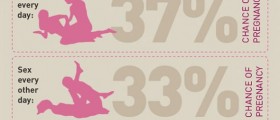
The reason for adding an additional 14 days to the estimation is because of the fact that most conceptions occur on day 14 of a menstrual cycle, based on a 28-day lapse. Calculating a due date from a woman's last menstrual cycle is not an exact science because of ovulation variation. These factors also vary because each woman's menstrual period will vary and some women could actually ovulate more than once a month, or even earlier or later. Some women will use an ovulation prediction kit or do basal body temperature charting. Calculating a due date from ovulation is consistently more accurate and is much easier than trying to guess based upon estimates from the last menstrual period. Calculating a precise ovulation date is never an easy thing to do because of many different issues. A woman can have irregular menstrual cycles, sporadic ovulation, or medical conditions and stress which will interfere with an accurate pinpointing of an average pattern of ovulation.
There is no tried and true method which will provide 100% accuracy in the prediction of a woman's due date, but tracking monthly menstrual cycles and noting any irregularities can eliminate some of the guesswork. An online due date ovulation calendar can be a very helpful way in which a woman can predict with a fair rate of certainty when her developing infant was conceived. For those searching for more accurate information as to a due date ovulation calendar, there are websites which will provide a good starting point. By making note of the last menstrual cycle and plugging in the average length of a period, a woman can get a very good idea of when she can expect to welcome her little bundle of joy into the world.
















Your thoughts on this
Loading...